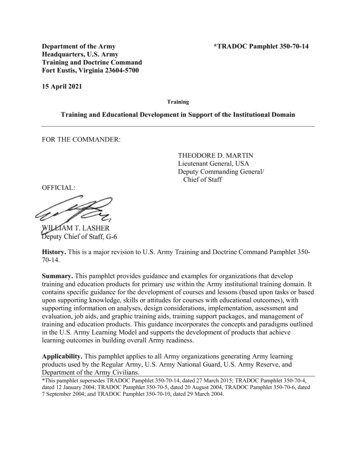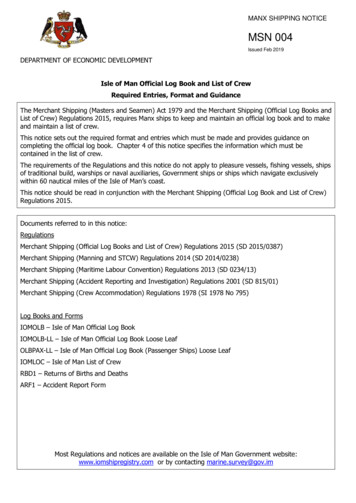
Transcription
Department of the ArmyHeadquarters, U.S. ArmyTraining and Doctrine CommandFort Eustis, Virginia 23604-5700*TRADOC Pamphlet 350-70-1415 April 2021TrainingTraining and Educational Development in Support of the Institutional DomainFOR THE COMMANDER:OFFICIAL:THEODORE D. MARTINLieutenant General, USADeputy Commanding General/Chief of StaffWILLIAM T. LASHERDeputy Chief of Staff, G-6History. This is a major revision to U.S. Army Training and Doctrine Command Pamphlet 35070-14.Summary. This pamphlet provides guidance and examples for organizations that developtraining and education products for primary use within the Army institutional training domain. Itcontains specific guidance for the development of courses and lessons (based upon tasks or basedupon supporting knowledge, skills or attitudes for courses with educational outcomes), withsupporting information on analyses, design considerations, implementation, assessment andevaluation, job aids, and graphic training aids, training support packages, and management oftraining and education products. This guidance incorporates the concepts and paradigms outlinedin the U.S. Army Learning Model and supports the development of products that achievelearning outcomes in building overall Army readiness.Applicability. This pamphlet applies to all Army organizations generating Army learningproducts used by the Regular Army, U.S. Army National Guard, U.S. Army Reserve, andDepartment of the Army Civilians.*This pamphlet supersedes TRADOC Pamphlet 350-70-14, dated 27 March 2015; TRADOC Pamphlet 350-70-4,dated 12 January 2004; TRADOC Pamphlet 350-70-5, dated 20 August 2004, TRADOC Pamphlet 350-70-6, dated7 September 2004; and TRADOC Pamphlet 350-70-10, dated 29 March 2004.
TRADOC Pamphlet 350-70-14Proponent and exception authority. The proponent for this pamphlet is the U.S. CombinedArms Center, Army University, Director for Learning Systems. The proponent has the authorityto approve exceptions or waivers to this pamphlet that are consistent with controlling law andregulations. Activities may request a waiver to this regulation by providing justification thatincludes a full analysis of the expected benefits and must include formal review by the activity’ssenior legal officer. All waiver requests will be endorsed by the commander or senior leader ofthe requesting activity and forwarded through their higher HQ to the policy proponent.Suggested improvements. Submit changes for improving this publication on Department ofArmy Form 2028 (Recommended Changes to Publications and Blank Forms) directly toDirectorate of Learning Systems (ATZL-AUL), The Army University, U.S. Army CombinedArms Center, 101 Meade Avenue, Building 102, Leavenworth, KS 66027-1356 or electronicallyto ArmyU@mail.mil.Distribution. This pamphlet is available in electronic media only at the U.S. Army Training andDoctrine Command Administrative Publications website (https://adminpubs.tradoc.army.mil).Summary of ChangesTraining and Doctrine Command Pamphlet 350-70-14Training and Education Development in Support of the Institutional Training DomainThis major revision, dated 15 April 2021o Removes 21st Century Soldier Competency language.o Supersedes U.S. Army Training and Doctrine Command pamphlets 350-70-4, 350-70-5, 35070-6, and 350-70-10 to consolidate and incorporate enduring guidance and procedures(throughout).o Expands the Analysis, Design, Development, Implementation, and Evaluation Processdiscussion and the Army University Experiential Learning Model.o Synchronizes content on mission analysis and job analysis with U.S. Training and DoctrineCommand Pamphlet 350-70-1 (chaps 3 and 4).o Explains and provides examples of task selection models (chap 4).o Elaborates on how to conduct job analysis surveys and how to conduct target audience analysissurveys (chaps 4 and 5).o Adds guidance for design, which addresses module- and course-level terminal learningobjectives (chap 6).2
TRADOC Pamphlet 350-70-14o Clarifies further the use of learning taxonomies in the development of learning objectives(chaps 2 and 7).o Includes guidance for developing lessons based on supporting knowledge, skills or attitudes forcourses with educational outcomes (chaps 6 and 7).o Adds guidance on job aids, graphic training aids, and training circulars (chap 8).o Adds a new chapter on implementation (chap 10).o Reorganizes assessment and testing content and incorporates enduring content from U.S.Training and Doctrine Command Pamphlet 350-70-5 (chap 11).o Reorganizes evaluation, quality and accreditation content (chap 12).o Adds synchronization meeting information for critical task and site selection boards, coursedesign reviews, and post-instructional conferences (para 4-11 and app C).o Adds course management plan (app H).o Updates titles, links and references throughout.3
TRADOC Pamphlet 350-70-14This page left blank intentionally.4
TRADOC Pamphlet 350-70-14ContentsPageChapter 1 Introduction . 131-1. Purpose .131-2. References .131-3. Explanation of abbreviations and terms .131-4. Scope .131-5. Records management requirements .131-6. Army learning policy and systems overview .131-7. Institutional learning processes and products .141-8. Army learning policy, systems, and Analysis, Design, Development, Implementation, andEvaluation Process .161-9. Regulation and pamphlet relationship.21Chapter 2 Proponent Requirements and Support of Institutional Training and Education Products. 212-1. Introduction .212-2. Training proponent information and identification numbers .222-3. Institutional training and education system .222-4. Mandatory training in institutions .222-5. Foreign disclosure restriction statements .222-6. Intellectual property/copyrighted/proprietary materials .232-7. Training and education development planning and management .252-8. Interfacing with other Army systems and processes .262-9. Application of Army Learning Model .27Chapter 3 Operational Force Drivers of Institutional Training Domain Learning Products . 273-1. Operational force drivers of institutional training domain learning products introduction273-2. Army Readiness Model .273-3. Needs analysis .283-4. Needs analysis team roles and duties .293-5. Needs analysis initiation .313-6. Needs analysis advance reparation .323-7. Identify performance problem .333-8. Identify problem in terms of learning outcomes .343-9. Establish scope .353-10. Clarify cause of identified performance deficiency(ies) .353-11. Identify solutions to performance deficiency(ies) .363-12. Recommend solution(s) to performance deficiency(ies) .383-13. Needs analysis documentation .393-14. Establish training and education development/training or education requirement .413-15. Improve education/training efficiency and effectiveness .413-16. Needs analysis quality control .423-17. Learning product analysis process overview .423-18. Mission analysis for learning product development .423-19. Safety, risk management, and environmental protection .43Chapter 4 Job Analysis . 454-1. Job analysis introduction .454-2. Job analysis process .455
TRADOC Pamphlet 350-70-14ContentsPage4-3. Identify/select job to analyze .494-4. Individual task identification .494-5. Develop/update target audience description .494-6. Conduct job familiarization/research .514-7. Compile total task inventory .524-8. Conduct job analysis survey .534-9. Conduct a critical task and site selection board .604-10. Obtain individual critical task list approval .664-11. Individual critical task list .664-12. Distribute approved critical task list .674-13. Job analysis quality control .684-14. Individual task analysis .684-15. Individual critical task list-to-lesson crosswalk .694-16. Terminal learning objective supporting eucational outcome-to-lesson crosswalk .69Chapter 5 Target and Targeted Audience Analysis . 705-1. Target and targeted audience analysis introduction .705-2. Targeted audience analysis for learners enrolled in a learning event .735-3. Determine population size, location, and availability .735-4. Data collection planning .745-5. Develop data collection instruments .745-6. Data collection .765-7. Data analysis procedure .785-8. Review goals and objectives .785-9. Determine reliability and validity of raw data .785-10. Prepare analysis data .805-11. Analyze data .805-12. Interpret findings .815-13. Gap analysis in relation to targeted audience analysis .81Chapter 6 Course Design and Development . 826-1. Course design and development introduction .826-2. Course design imperatives .836-3. Course design considerations .836-4. Course design requirements .866-5. Course purpose and scope .876-6. Course prerequisites .886-7. Course structure and sequence .896-8. Course design components.916-9. Course development .956-10. Resource requirements .1016-11. Career map .1026-12. Quality control for courses (evaluation and validation).102Chapter 7 Lessons and Lesson Plans . 1057-1. Lessons and lesson plans introduction .1057-2. Analysis for lessons .1067-3. Learning objectives and learning domains.1066
TRADOC Pamphlet 350-70-14ContentsPage7-4. Sequencing lessons and learning objectives .1157-5. Lesson design .1177-6. Lesson design guidelines .1187-7. Learning step activities .1197-8. Developing learning step activities .1207-9. Lesson numbers.1227-10. Lesson titles.1247-11. Lesson plan development .1257-12. Modes of instructional delivery for lessons .1297-13. Instructional strategy and methods of instruction .1297-15. Lesson academic hours .1337-16. Instructor contact hours .1337-17. Instructor actions .1347-18. Media .1387-19. Media delivery .1407-20. Resources required .1437-21. Measuring learner performance: assessment .1447-22. Administrative data .1447-23. Quality control for lesson plans .145Chapter 8 Job Aids, Graphic Training Aids, and Training Circulars . 1468-1. Job aids and graphic training aids .1468-2. Job aid application .1468-3. Job aid creation .1478-4. Job aid validation .1508-5. Graphic training aid design and development.1508-6. Graphic training aid quality control .1528-7. Training circulars .1528-8. Training circular analysis and design.1528-9. Training circular development .1538-10. Training circular quality control .153Chapter 9 Individual Training Support Packages . 1549-1. Individual training support packages introduction.1549-2. Training Support Package analysis and numbering .1549-3. Training Support Package design .1549-4. Training Support Package development .1549-5. Training Support Package quality control .156Chapter 10 Implementation. 15610-1. Implementation introduction .15610-2. Proponent preparation .15810-3. Training and education developer preparation.15810-4. Instructor/facilitator and material preparation .15910-5. Evaluation .16010-6. Closeout management .1637
TRADOC Pamphlet 350-70-14ContentsPageChapter 11 Assessment and Testing . 16511-1. Assessment and testing purpose .165Section I Assessment Overview .16511-2. Measuring learner performance: assessment .16511-3. Assessment types .16611-4. Assessment methods .16611-5. Assessment/test development or revision decision-making.16711-6. Assessment design and development .16711-7. Assessment/assessment item analysis .16811-8. Managing and controlling assessments .168Section II Assessment/test development .17011-9. Assessment/test development .17011-10. Performance-based assessment/testing .17011-11. Performance and knowledge-based assessments/tests .17011-12. Test placement in a course .17511-13. Pretests .17511-14. Check on learning .17611-15. Within-course assessments/tests .17711-16. Post-assessment/test .17811-17. Assessment/test design .17911-18. Criterion-referenced test development .18711-19. Criterion-referenced test characteristics.18711-20. Turning learning objectives into assessment/test items .19111-21. Sequence of development .19311-22. Assessment/test development project steps .19311-23. Planning for development of assessments/assessment items .19411-24. Determine course assessment/test policy and procedures.19411-25. Write an assessment plan .19611-26. Write an individual student assessment plan .19611-27. Construct and validate assessment/test items.19711-28. Construct and validate assessment rubrics .19711-29. Write assessment/test control measures .19811-30. Implement assessment/test plan .19911-31. Performance assessment/test development .19911-32. Select, review, and revise performance objectives .20011-33. Design performance assessment/test items .20011-34. Validation of performance assessment/test items .20211-35. Review and revise knowledge/cognitive skills-based learning objectives .20411-36. Design knowledge/cognitive skills assessment/test items .20411-37. Validate knowledge/cognitive skills-based assessment/test items.20611-38. Analyze assessment/test results .207Chapter 12 Evaluation, Quality, and Accreditation . 20812-1. Evaluation, quality, and accreditation overview .20812-2. Types of evaluation .2098
TRADOC Pamphlet 350-70-14ContentsPage12-3. Internal evaluation.20912-4. External evaluation .21012-5. Evaluation process .21212-6. Planning evaluations .21412-7. Collecting evaluation data .21612-8. Preparing and analyzing evaluation data .21712-9. Preparing evaluation reports .21912-10. Conducting evaluation follow-up.22012-11. Accreditation .221Chapter 13 Managing Training and Education Products . 22213-1. Managing training and education products introduction .22213-2. Proponent guidance for product management .22213-3. Automation of training and education products .22413-4. Quality control of training and education products .23113-5. Distribution of learning products .23113-6. Management of common core training and education .23213-7. Course management .23213-8. Course quality assurance and workload management .233Appendix A. References . 234Appendix B. Setting Test Standa
o Reorganizes assessment and testing content and incorporates enduring content from U.S. Training and Doctrine Command Pamphlet 350-70-5 (chap 11). o Reorganizes evaluation, quality and accreditation content (chap 12).











